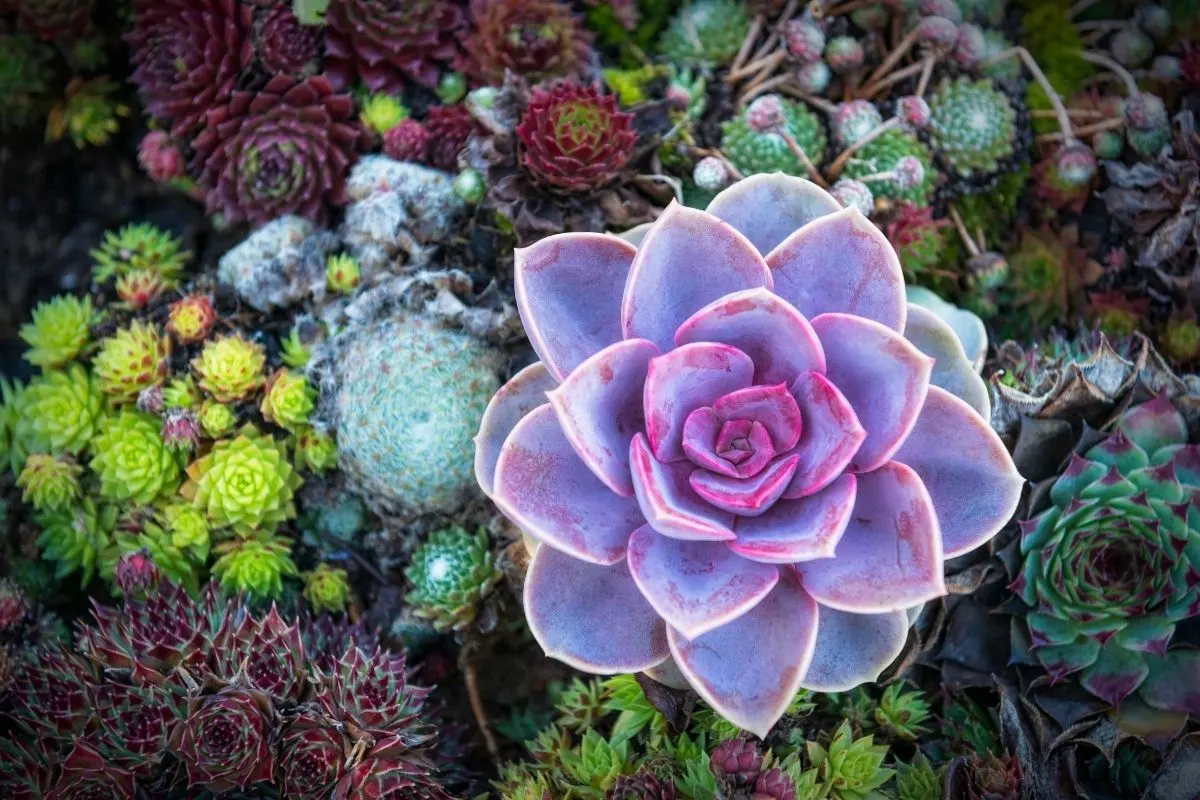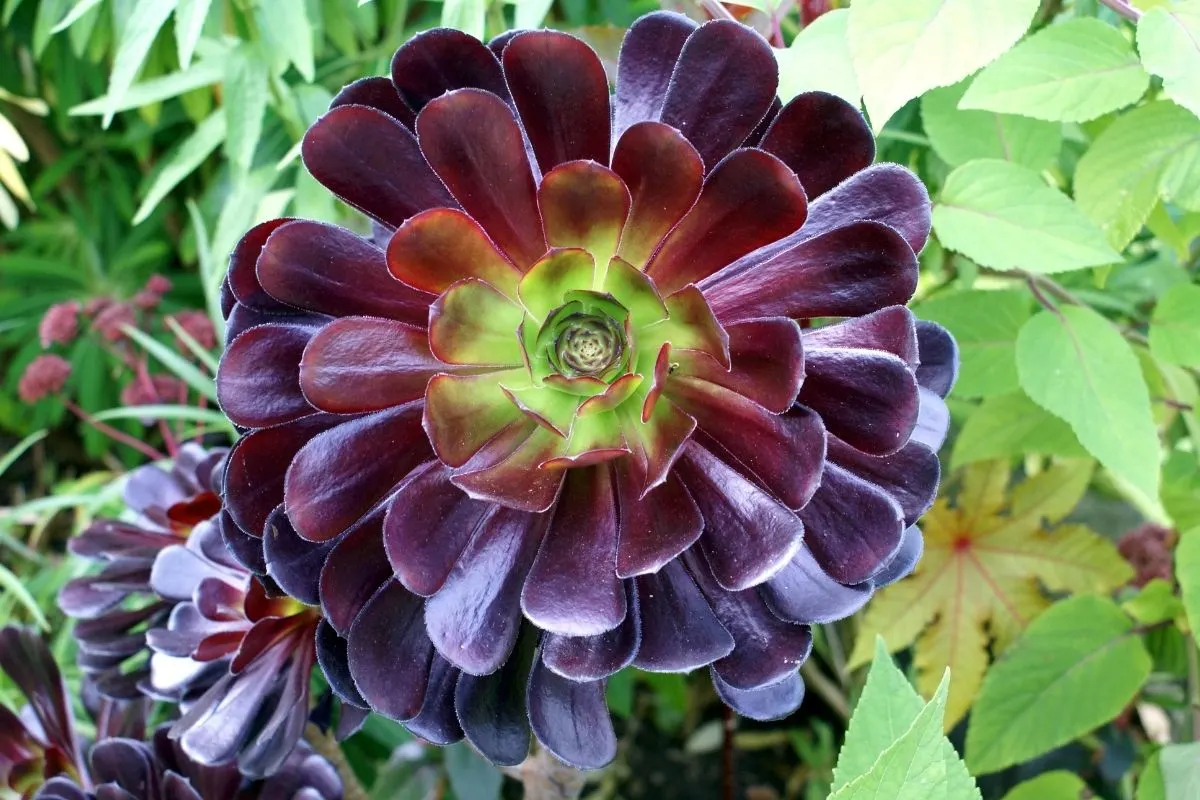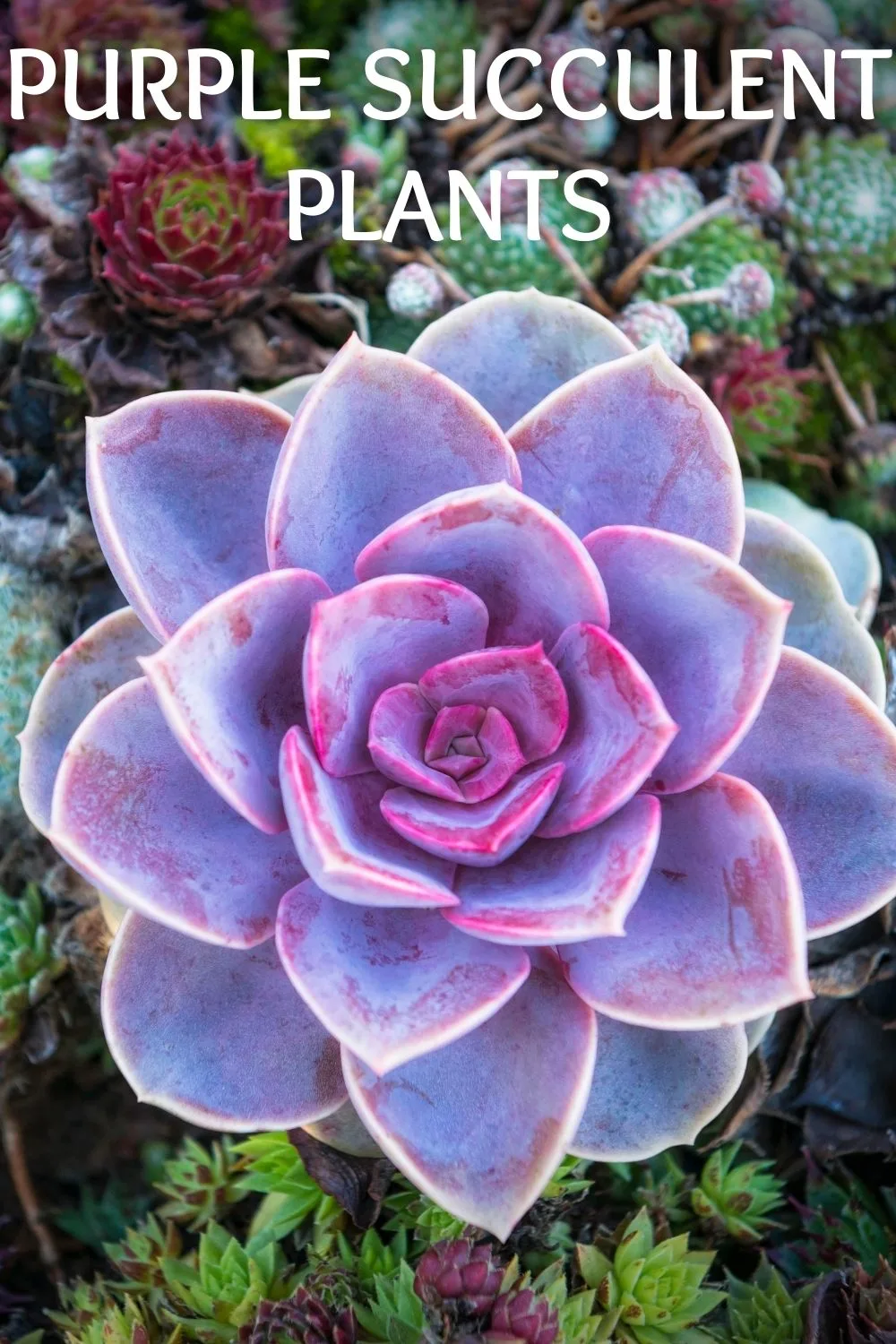Succulents are a popular species of plants and they’re a great entry into houseplants and gardening for new people, due to how easy they are to care for. What some people don’t know is that they aren’t always just green. Of the many colors they can be, purple succulent plants are some of my favorites.
The leaves of your succulents don’t have to be green only. Many come in shades of pink, purple, yellow, and more. Sometimes they will have light purple or pink edges. Others will have dark purple succulent leaves that look almost black. The different colors and unique appearance are part of what make growing succulents so much fun.

Let’s explore some of the best purple succulents for your garden.
What Are Purple Succulents?
If a succulent has purple flowers, purple leaves, or any shades of purple in it, we can classify it as a purple succulent. For most of these, the purple colors come out more when they are exposed to more sunlight. Some of them start off with purple colors, while others develop it over time as the plant matures.
They look great in rock gardens, on the windowsill, and anywhere else they can get bright light when needed. Most varieties need well-draining soil, and most can withstand cold weather, at least to a degree. However, be sure to learn about the best conditions for your species and variety of succulents, so that you can help them thrive and be their best.
Why choose succulents for your garden?
Why are succulents a good choice for many people? The simplest answer is how easy they are to care for. Most species can also be very tolerant of cold temperatures, which is another reason they are so popular. Here are some reasons you should consider them:
- They’re easy to care for
- They come in a variety of shapes and colors
- They can grow indoors or out
- They are affordable
- They thrive when planted with other plants
Why choose purple succulents?
What are some reasons you might consider purple plants for your garden? Purple succulents are popular because they look so nice and interesting. This can be a great way to add a pop of color here and there to your garden.
However, they are also very versatile and can be used in different types of gardens, in containers, indoors and outdoors, and with other complementary plants. Purple is my favorite color, and I was surprised when I saw how many purple succulents there actually are to choose from.
Now let’s look at some of my favorite purple succulents. You can’t go wrong with a beautiful plant from this list.
1. Royal flush (Pleiospilosnelii)
Royal flush is a small succulent of about three inches high and up to four inches wide. It has three to four purple leaves with holes in the centers. Named for its royal purple leaves, it can also bloom pink or white flowers.
2. Purple flush (Senecio herreanus)
This one is a great choice if you plan to hang it from a basket or hanging planter. This plant is sometimes also called string of beads because when the green parts grow, that’s exactly what they look like. It has green, oval-shaped leaves and purple stems that really pop, especially as it grows and trails down. It can also bloom white flowers.
3. Purple moon cactus (Gymnocalycium)
This succulent is a species of cactus native to South America. They rarely get over six inches in height and they’re known for their bright flowers. As far as purple succulents go, this one is very easy to take care of and can hold up alright from slight neglect. You can propagate the offsets.
Learn more about flowering succulent plants.
4. Purple pearl (Echeveria)
This small succulent has light purple leaves and grows from six to eight inches tall, on average. It can bloom pink flowers that complement the light purple leaves. It loves bright indoor lights or low natural sunlight as opposed to full sun. Like pretty much all the plants on this list, Echeveria purple pearl needs well-draining soil.
5. Purple beauty (Sempervivum)
Now we have a tiny succulent with blue-green leaves and purple centers. It grows in a rosette shape and can be as much as six inches wide. They rarely get taller than three inches. It does best in a lot of direct sunlight.
6. Purple rose (Aeonium arboretum var. atropurpureum)
Purple rose is a beautiful branching succulent with rosettes of dark purple leaves. This one is similar to the popular Zwartkop, but it features smaller rosettes and shorter stems. They grow from 2 to 3 feet tall and they prefer light shade over a full sun location. However, the sun exposure will bring out the purple color (just don’t overdo it).
7. Santa Rita prickly pear (Opuntia santarita)
This is a unique cactus found in the southwestern region of the US. It has green and purple pads and while it can grow as much as six feet high and over nine feet wide, it is the most colorful when it is smaller in size.
8. Violet prickly pear (Opuntia violaceas var. gosseliniana)
Sometimes this variety is called milk-chocolate spine prickly pear. It’s smaller than the related purple prickly pear and can grow up to about two feet tall and two feet wide. Its green pads have tinges of pink, purple, or dark purple, and the sharp spines are usually brown.
9. Rainbow hedgehog cactus (Echinocereus pectinatus)
Here’s another fun little succulent that makes a perfect addition to any garden. It has unique violet spines and can grow up to 14 inches tall and as much as five inches wide. It can produce bright pink or white flowers, adding to its beauty.
10. Trailing jade (Senecio jacobsenii)
Trailing jade is another great purple succulent and despite its name, it is not related to Crassula Jades that most people are familiar with. Because it trails, it works great in a hanging basket. This native of southern Africa can grow as much as 12 inches long. It rarely blooms but if it does, it has bright orange flowers with a strong odor to them.
11. Rubra (Lithops optica)
Rubia is a small purple succulent with thick, pebble-like leaves. The leaves are typically about one inch long, and the stem is short and not usually visible as the plant grows full. When in bloom, they can produce white flowers that resemble daisies.
12. Black prince (Echeveria)
This popular purple succulent has very dark green and deep purple leaves that make it appear almost black, hence the name. The dark colors in this succulent will become more pronounced with more sun exposure.
13. Desert bloom (Sempervivum)
This one is often called a “hens and chicks” succulent. It has leaves in shades of green, yellow, brown, pink, and purple, which is why it’s on this list. The purple color on this one actually gets stronger when it is exposed to the cold. So, you’ll see this one get more purply in the winter weather. In the summer, it can bloom light pink flowers.
14. Desert surprise (Kalanchoe humilis)
This plant is native to Africa and has very unique green leaves with streaks of purple colors in them. The markings appear horizontally across the flat, wide leaves. The purple becomes more intensified with more sunlight. It can grow as much as three feet high and is bushy.
15. Black rose (Aeonium arboretum ‘Zwartkop)
Black rose is sometimes also called black tree aeoniums. It has striking black foliage that appears almost black, similar to black prince. It can grow over three feet high and the waxy, purple leaves form rosettes, which is where it gets its common name. It needs a lot of direct sunlight to keep these deeper shades of purple.
16. Raspberry ice (Sempervivum)
Raspberry ice is a variety of Sempervivum sometimes called Houseleek raspberry ice. It’s a dense succulent perennial that has a low mound of foliage with rosettes that start off red and then turn purple over time. It grows about two inches tall.
17. Red carpet (Sedum spurium)
This fun succulent is sometimes called Dragon’s Blood stonecrop. This small, mimicry plant has leaves that are green, reddish-purple, and deep burgundy. Their shades can vary based on season and lighting conditions. More light and colder weather will bring the deep purple shades out more. It’s one of the hardiest sedums when it comes to cold tolerance, so this can be a good choice if you live somewhere that gets cold in winter, or in a desert-like climate that is hot in the day and cold at night.
18. Purple pinwheel (Aeonium arboretum Electra)

Purple pinwheel is similar to other aeoniums but this one has rosettes with shorter, fuller leaves. The foliage will start out green, but in time, more purple tones will come in. It can tolerate light levels from partial shade to full sun. The more sun it has, the more the purple colors come through.
19. Sunrise succulent (Anacampseros rufescens)
Also called sand rose, this low-growing succulent plant is native to South Africa and features colorful leaves in shades of green, yellow-green, pink, and purple. It has thin, white hairs growing around the leaves and it forms in clusters that spread out over time. It’s a low-maintenance plant that makes a great addition to your succulent garden.
Purple Succulent Plants – Conclusion
It’s easy to see why people like these so much. From a beautiful rosette to a tall prickly pear cactus, there is so much variety in these purple succulents. Not all of them have deep purple foliage all year round, and some do better outdoors whereas others are best indoors. But with some research, you’re sure to find the perfect ones to meet your needs. Do you have a favorite succulent from this list?






















 ?. ts.dhung.
?. ts.dhung.
